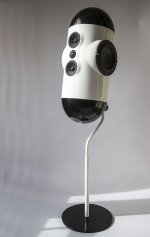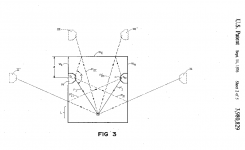It's interesting to go down this path and learn of the extensive set of compromises involved. Still, I'm not arguing.Soffit mount and Corner loading are the best we can do execution wise right?
One general point loosely presented is that when you leave loose ends in your design which create spatial artefacts, there are limits to repairing the damage. In most cases it's better to do it right in the first place.
Woah. Just came back to read and the thread is fairly long. Just to clarify my OP thoughts were more what goes on inside a tight cabinet with a driver not having space around it, ie backwave cannot clear driver chassis easily and ends up reflecting off sides back into the cone
Absorbent on the rear of the speaker frame and side walls of box, but leave a clear central path for high velocity bass air movement.
my OP thoughts were more what goes on inside a tight cabinet with a driver not having space around it
OK, the pioneers loosely covered the back of the driver with cheesecloth, then lined the area with loose acoustic insulation to 'taste'.
GM
how is this done, if you put a woofer into a wall would not this exagerate the resonance between this wall and its parallel wall? with a free standing speaker you can move it out from the wall to minimize resonances
I don't know enough to agree or dispute, but according to Fig 59 on page 21 here:
http://www.wghwoodworking.com/audio/multsubs.pdf
Configs 10 and 12 are suitable for in-wall setups and are two (out of the top three) best practical ones for smooth bass.
Alternately, install a DBA.
Personally, with little more than hubris and god-given self-confidence to speak to what I do not actually know, I believe that very wide and very narrow baffles achieve much the same when it comes to diffraction. We remove the edge energy from playing a significant part. Very narrow baffles by having the diffraction occur at or nearly at the same time as the original impulse. Very wide baffles by pushing much more of the signal into the room before diffraction, leaving a mere ghost of a diffraction signature at the edge of the baffle.
I say I do not know this but I will say, the best imaging speakers, one's which not only image well but seem to capture the original hall's recording environment the best tend to be wide baffles, not narrow.
Troels goes into some description here:
Poor Man'
Best,
Erik
My own experience has shown both extremely narrow (4”) and extremely wide (26”) baffles image exceptionally well.....the 4”being a commercial MMTMM from a now defunct company called Athena and the 26” being an OB DIY effort . Those little Athena towers were simply amazing.....till I blew up a couple of drivers. They stay as one day I’ll repurpose them in a DIY design of some kind. The OBs were great too.......but needed a purpose furnished a positioned space......not very practical......or not enough performance value to support the impractical use of space.
I don't know enough to agree or dispute, but according to Fig 59 on page 21 here:
http://www.wghwoodworking.com/audio/multsubs.pdf
yes, but that requires that you put a low frequency speaker to the parallel wall as well, it is like a force cancelation setup in a loudspeaker. but what if you do not, what happens then?
I started selling these with production on demand after years of experimentation:

The design filosophy is that the surfaces producing sounds have to be small compared to the wavelengths they are producing. The baffle is part of the surface producing sound. The aim is to create a point source for sound.
This design is essentially baffle-less for all drivers. The result is the best isolation of instruments and sound staging of any speaker I have tested them against.
Since the woofers are firing in opposite directions, no vibrations are introduced into the enclosure. Which for that reason can be made very light weight. In the speaker shown, total weight is about 7 kg, with 2.7 kg for the enclosure. Not much for a 25 liter enclosure that can handle 500 Watts and fill a large room in a big way.
They are based on an old patent of mine. I still think it is a good read on some fundamentals.
US5710395A - Helmholtz resonator loudspeaker
- Google Patents

The design filosophy is that the surfaces producing sounds have to be small compared to the wavelengths they are producing. The baffle is part of the surface producing sound. The aim is to create a point source for sound.
This design is essentially baffle-less for all drivers. The result is the best isolation of instruments and sound staging of any speaker I have tested them against.
Since the woofers are firing in opposite directions, no vibrations are introduced into the enclosure. Which for that reason can be made very light weight. In the speaker shown, total weight is about 7 kg, with 2.7 kg for the enclosure. Not much for a 25 liter enclosure that can handle 500 Watts and fill a large room in a big way.
They are based on an old patent of mine. I still think it is a good read on some fundamentals.
US5710395A - Helmholtz resonator loudspeaker
- Google Patents
- I don't know how I ended up with 32" wide baffles (cause I used the 15m in a 3 way) but I am going to pretend that it was on purposeMy own experience has shown both extremely narrow (4”) and extremely wide (26”) baffles image exceptionally well...
 🙄
🙄 It sounds to me, via your description, that keeping the baffle edge effects, on one extreme side (low side big baffle), or the other (high side small baffle) is no different than wise (my) xover placement philosophy....place any where but in the midrange....
Sic transit musica amans...
For us, listening to audio is a calling, a major hobby at the least. Philosophers of old would keep a skull on their table, supposed to remind them of inevitable mortality. So why not coffin shaped speakers for us, for the same reasons? 🙂
Now when one is getting old enough to purchase a serious big Loudspeaker, you don't want this coffin watchs you all the days like a mirror... seing it at 90%, i.e. narrow baffle is politically... nicer 😀!
For us, listening to audio is a calling, a major hobby at the least. Philosophers of old would keep a skull on their table, supposed to remind them of inevitable mortality. So why not coffin shaped speakers for us, for the same reasons? 🙂
Big boxes are ugly....good point. =( I've been spending my days trying to figure out how to beautify a 32x17x32 box for a midrange.....=(
I guess we just solved why the industry went with small enclosures. Well its been fun....=)
I guess we just solved why the industry went with small enclosures. Well its been fun....=)
Last edited:
Woah. Just came back to read and the thread is fairly long. Just to clarify my OP thoughts were more what goes on inside a tight cabinet with a driver not having space around it, ie backwave cannot clear driver chassis easily and ends up reflecting off sides back into the cone
I have certainly experienced that. Get the inner walls (or the back of th ebox) too close to the driver one gets midrsnge colouration, cuppiness in voices.
The original millSize miniOnken, we went thru 3 prototypes, each getting wider, until the sonics had cleaned up.
dave
I started selling these with production on demand after years of experimentation:
View attachment 904867
The design filosophy is that the surfaces producing sounds have to be small compared to the wavelengths they are producing. The baffle is part of the surface producing sound. The aim is to create a point source for sound.
This design is essentially baffle-less for all drivers. The result is the best isolation of instruments and sound staging of any speaker I have tested them against.
Since the woofers are firing in opposite directions, no vibrations are introduced into the enclosure. Which for that reason can be made very light weight. In the speaker shown, total weight is about 7 kg, with 2.7 kg for the enclosure. Not much for a 25 liter enclosure that can handle 500 Watts and fill a large room in a big way.
They are based on an old patent of mine. I still think it is a good read on some fundamentals.
US5710395A - Helmholtz resonator loudspeaker
- Google Patents
Great stuff Vacuphile. Very clever design.
I've made few drawings with similar arangement but with woofers at the ends of the pipe, closed cabinet, dsp controlled, of course. Haven't moved this one from the drawing board though.
Do you have any measurements - on, off axis, waterfall, impedance ?
I'm guessing it is passive design.
I have certainly experienced that. Get the inner walls (or the back of th ebox) too close to the driver one gets midrsnge colouration, cuppiness in voices.
The original millSize miniOnken, we went thru 3 prototypes, each getting wider, until the sonics had cleaned up.
dave
Is the cuppy sound partly dependent on cone material?
"Big boxes are ugly"
Aesthetics are surely a subjective issue, but big speakers can bean imposition and dominate a room. But ask yourself how you would feel if you had a pair of monitors the size of ping-pong balls which produced perfect sound. Disconcerting?
'Cuppy' usually implies a cavity related sound.
Aesthetics are surely a subjective issue, but big speakers can bean imposition and dominate a room. But ask yourself how you would feel if you had a pair of monitors the size of ping-pong balls which produced perfect sound. Disconcerting?
'Cuppy' usually implies a cavity related sound.
- Home
- Loudspeakers
- Multi-Way
- Are modern narrow baffle designs inherently flawed?
